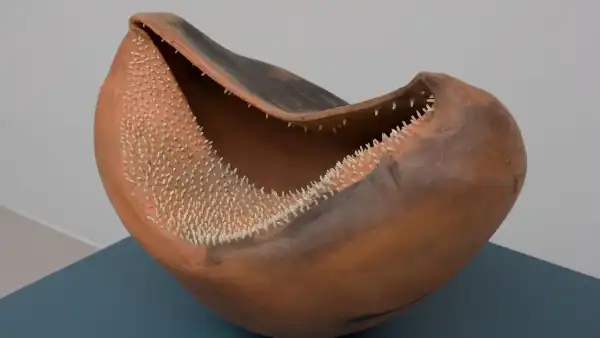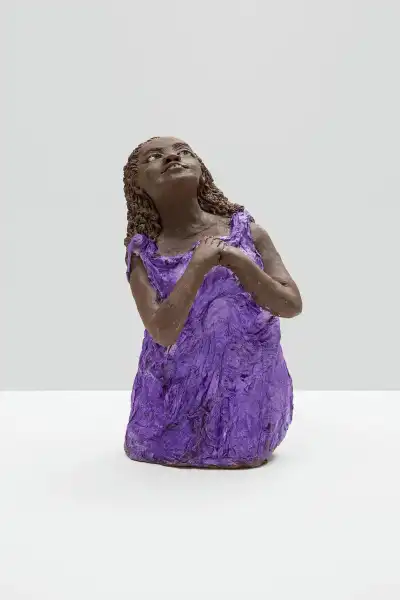
Save this storySave this storySave this storySave this story
The link between Adebunmi Gbadebo and her chosen medium, clay, suggests a form of appeal—on Gbadebo’s side. Among the religiously inclined, a potter is often viewed as akin to a sovereign; they perceive a kindred, almost self-punishing, connection to the notion of clay as the unassuming, passive essence of life from which they originate. Yet, clay may offer resistance. Under specific conditions, clay might opt for ruin. Gbadebo ardently aims to preserve clay in a near-ethereal condition, a realm of near-animation, a fossilized resolve, allowing it to impart, fashioned upon its stand, its innermost contemplations.
Gbadebo periodically undertakes a voyage. From her Philadelphia work space, she journey’s to True Blue Cemetery, a consecrated resting place for those formerly enslaved and their kin, situated in Fort Motte, South Carolina. The cemetery borrows its designation from the adjacent estate, True Blue; the estate, consequently, gained its title from its valued commodity: indigo. The concentration of iron within the bedrock of this locale is insufficient for the creation of iron for steel, yet adequately present to paint the earth in shades of rust-red. Gbadebo excavates the soil manually, amassing tanks brimming with it, a sum nearing eight hundred pounds, which she transports back to her studio, there to refine it, combine it with liquids and other clay variants, then transforming it into workable material. She then sculpts the clay into an assortment of rounded receptacles, squat forms approximately eighteen inches across, resembling containers, pelvic forms, and/or seeds planted just as the catastrophe occurs. Gbadebo sets her creations ablaze on a pair of occasions, with a portion undergoing a variant of the Japanese raku technique, the initial firing usually attaining temperatures of around eighteen hundred degrees, with the ensuing fire peaking around one thousand degrees. It’s at this juncture that the vessels get pulled out. They withstand the intensity of a precipitous thermal plunge, succeeded by applications of heated sawdust, locks of hair, and sucrose—that Gbadebo articulated, the other day, as a “closing entombment.” The periphery of mortality. The carbon innate within the combustible infuses itself into the veneer of the ceramics, etching patterns of black, nuances which Gbadebo manages to influence to a specific degree. The vessels, following the conveyance of their mysterious communiqué, receive names derived from individuals interred at reddish-clay plantations. “Ellis Sanders,” “John Ricen Ravenell,” “Maum Hannah”: these monikers belong to Gbadebo’s forebears. She unearthed them amid the review of a South Carolina slaveholder’s directive. Lately, she portrayed herself to me as a sorrowing soul.
I remained unaware of Gbadebo’s familial narrative when I engaged with her introductory solo presentation, entitled “Watch Out for the Ghosts” (a nod to Amiri Baraka’s poignant verse “Why’s/Wise”), hosted at the Nicola Vassell Gallery, during early September. Nevertheless, I discerned a sense of agitation within the ambiance, a sensation that lingered and eventually solidified into something tangible. The repercussions of the showing evoked feelings of . . . piercing. Twinges crept up the appendage. Tactility is the disregarded faculty within the gallery domain, yet stirred, during this exposition, via Gbadebo’s external layers. Though, the spectral sensation needs a moment to register. Distantly, the analysis springs from the vista, which finds pleasure in the expansive mouths, the undulations by the footing that devoutly mirror the custom of venerating the female figure. The receptacles, perched on blue-green stands, extend an invitation, projecting timelessness. But, as proximity increases, the focal point of energy transitions from contour to “outer layer” and enclosed emptiness. This is an altogether unique performance. Gbadebo fills, as a prime example, a specific holder suggestive of a celebratory fertility effigy with heaps of grain. The agreeable open orifice now projects, following closer observation, as a never-ending ravine, with the grain resembling larvae, replicating indefinitely. Elsewhere, Gbadebo singles out each kernel, lodging them into the vessel’s outer shell, thus positioning them upright and extroverted. Within another creation, they jut akin to dentition. Other natural components are engaged amid her mixed-medium artistry, a dalliance with a prohibition against what constitutes “material”; human fleece, horsehair, pine leaves, germs, animal bone, limbs from cherry trees. So essentially, within this locale, interment urns are vibrant—history is alive.
Gbadebo is thirty-three years in age. Born to a Black American mother and a Nigerian father, and brought up in Maplewood, New Jersey. While pursuing art schooling, she held scant regard for Eurocentric painting teachings, which she felt were thrust upon her. She requires room, heaviness, and spatiality. And vitality. One senses Gbadebo, also a Yoruba priestess, experiencing depletion amidst the lifeless. Her initial components encompassed strands of hair, accumulated at barber establishments or via distant benefactors. (Her digital portal includes a mailing address for tress contributions.) Following the unearthing of her maternal lineage’s final abode, subsequent to her mother’s passing, Gbadebo broadened her materials to embody the yields of slavery’s manufacturing—grain, cotton, and indigo. Her supplemental medium entails documentations, interventions on the solid logs of proper History, forged via clay, estate soil, and cotton fiber, coupled with paints derived from watered soil and indigo. All her artistic efforts brandish traces of their formation. They invariably evoke the feeling that the artist just departed.

“Glory (A Taste of Sweetness after Near Death)” (2001).Photograph by Greg Carideo / Collection of Martin and Rebecca Eisenberg / Courtesy Bronx Museum
Upon connecting with Gbadebo, it dawned on me that I had been referring to her alternately as a sculptor and a ceramicist. Which term held precision? Precision formed the crux. “I surmise my leanings rest more with the concept of being identified as a sculptor, although I’m amenable to all descriptors, yet these works are sculptural,” she conveyed.
Clay spurs us. The emergence of a ceramics exposition nearly mandates a preemptive action confronting protracted prejudices about the medium within the sphere of artistry. Ceramics sustained historical depreciation as being minor, domestic, feminine, and biblically trite—a utilitarian craft, inferior within the creative structure when pitted against the masculinized discipline of sculpture. The California Clay Movement of the nineteen-sixties, championed by Peter Voulkos, garners widespread recognition as the fulcrum in ceramics’ standing—the Abstract Expressionist uprising for a medium seeking enhancement. The 1981 Whitney Showing immortalizing Voulkos, Kenneth Price, amongst others carries the designation “Ceramic Sculpture: Six Artists,” akin to branding a display “Bronze Sculpture: Six Artists.” Might it stem moreover from the earliness of ceramics throughout human chronology, bearing connotations mirroring the pre-civilized, Hobbesian situation, pre-dating even lithic statuary across specific continents? Ceramics traditionally serving as the artistry of the disadvantaged seeming culpable, too. Criticisms directed at utility, the vexation plaguing a twentieth-century art world undergoing Dadaism. At the Met, dating back to 2023, “Hear Me Now: The Black Potters of Old Edgefield, South Carolina,” the awe-inspiring manifestations of David Drake, an artisan hailing from the mid-nineteenth century, presented themselves beside receptacles from contemporary artists comprising Simone Leigh, Woody De Othello, as well as Gbadebo—a means to induct Drake into the role of ancestor. Nonetheless, Drake, the creator of manifold sublime and daunting works amidst enslavement, acknowledged his station as an artist. Varying renditions of “I fashioned this pot” exist etched eternally upon his receptacles.
This period provides an opportune moment for contemplation on the enigmas of clay. Within the Bronx Museum, an exhibit entitled “Ministry” arranges upon altar-resembling platforms the miniatures crafted by Reverend Joyce McDonald, hand-forged. McDonald crafts captivating and forceful busts exuding auras of religious reliquaries, chronicling moments of her existence, or existences; McDonald detected her artistic leanings through an art-assisted therapy lesson subsequent to her HIV diagnosis. In the exhibition catalogue, Kyle Croft, the curator, recalls an instructor’s deployment of the Lazarus narrative to clarify McDonald’s sentiment concerning rebirth. (Post revival, this particular saint recounted a jest upon spotting a youth pilfering a clay vessel: “The clay purloins the clay.”) And at the Ford Foundation Gbadebo’s contributions materialize anew, amid the display “Body Vessel Clay: Black Women, Ceramics, & Contemporary Art,” juxtaposed alongside Simone Leigh, Phoebe Collings-James, and allied contemporaries. Orchestrated by Dr. Jarah Das, a researcher specializing in clay and its bodily intertwining, the presentation articulates a refreshing declaration apropos a parallel movement within clay, revolving not around Voulkos yet centered around the Nigerian potter Ladi Dosei Kwali, a supreme alchemist regarding Gbari design coupled with British studio mannerisms. Akin to Kwali, or conceivably succeeding Kwali, Gbadebo adopts a coiling approach, channeling her personal physique encompassing the clay, as opposed to adopting a static stance, permitting the clay to revolve repeatedly. Accounting for the provenance of the clay, Gbadebo spins her individual essence. ♦
A prior iteration of this piece inaccurately portrayed the operators of True Blue Plantation, as well as the slave proprietor whose testament Gbadebo scrutinized, and rendered an inexact description regarding the burial setting for particular ancestors belonging to Gbadebo.
Sourse: newyorker.com






